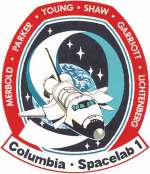STS-9
|
|
| Mission Insignia | |
|---|---|
 | |
| Mission Statistics | |
| Mission: | STS-9 |
| Shuttle: | Columbia |
| Launch Pad: | 39A |
| Launch: | November 28, 1983 16:00:00 UTC |
| Landing: | December 12, 1983 23:47:23 UTC Edwards AFB, California, Runway 17 |
| Duration: | 10 days, 7 hours, 47 minutes, 24 seconds |
| Orbit Altitude: | 155 nautical miles |
| Orbit Inclination: | 57.0 degrees |
| Orbits: | 167 |
| Miles Traveled: | 4,295,853 miles | Crew photo |
| Missing image S83-35017.jpg L-R: Garriott, Lichtenberg, Shaw, Young, Merbold, Parker L-R: Garriott, Lichtenberg, Shaw, Young, Merbold, Parker | |
STS-9 (Spacelab 1) was a United States Space Shuttle mission, the 6th mission of the Columbia orbiter.
| Contents |
Crew
- Commander: John W. Young (flew on Gemini 3, Gemini 10, Apollo 10, Apollo 16, STS-1, & STS-9)
- Pilot: Brewster H. Shaw (flew on STS-9, STS-61-B & STS-28)
- Mission Specialist 1: Owen Garriott (flew on Skylab 3 & STS-9)
- Mission Specialist 2: Robert A. Parker (flew on STS-9 & STS-35)
- Payload Specialist 1: Ulf Merbold (flew on STS-9, STS-42 & Euromir 94)
- Payload Specialist 2: Byron K. Lichtenberg (flew on STS-9 & STS-45)
Backup Payload Specialists
- Alternate Payload Specialist: Wubbo Ockels
- Alternate Payload Specialist: Michael Lampton
Mission Parameters
- Mass:
- Orbiter Liftoff: 112,318 kg
- Orbiter Landing: 99,800 kg
- Payload: 15,088 kg
- Perigee: 241 km
- Apogee: 254 km
- Inclination: 57°
- Period: 89.5 min
Mission objective
For the STS-9 mission Columbia was once again back in orbit. The launch occurred at ll a.m. EST, Nov. 28, 1983, after a 2-month delay because of a nozzle problem with one of the SRBs. This necessitated moving the vehicle back to the Vehicle Assembly Building where the nozzle was replaced.
The 6-member crew—a manned space flight record at the time—included John W. Young, commander, on his second Shuttle flight; Brewster H. Shaw, pilot; Owen Garriott and Robert A. Parker, both mission specialists; and Byron K. Lichtenberg and Ulf Merbold payload specialists—the first two non-astronauts to fly on the Shuttle. Merbold, a citizen of West Germany, also was the first foreign citizen to participate in a Shuttle flight. Lichtenberg was a researcher at Massachusetts Institute of Technology.
The mission was devoted entirely to Spacelab l, a joint NASA/European Space Agency (ESA) program designed to demonstrate the ability to conduct advanced scientific research in space, with astronauts and payload specialists working in the Spacelab module and coordinating their efforts with scientists at the Marshall Payload Operations Control Center (POCC) then located at the Johnson Space Center. Funding for Spacelab l was provided by ESA.
The crew was divided into two teams, each working 12-hour shifts for the duration of the mission. Young, Parker and Merbold formed the Red Team, while Shaw, Garriott and Lichtenberg made up the Blue Team. Usually, the commander and the pilot team members were assigned to the flight deck, while the mission and payload specialists worked inside the Spacelab.
Seventy-two scientific experiments were carried out in the fields of atmospheric and plasma physics, astronomy, solar physics, material sciences, technology, life sciences and Earth observations. The effort went so well that the mission was extended an additional day to 10 days, making it the longest duration Shuttle flight to date.
The Spacelab l mission was highly successful, having proved the feasibility of the concept of carrying out complex experiments in space using non-NASA persons trained as payload specialists in collaboration with a POCC. Moreover, the Tracking and Data Relay Satellite, now fully operational, was able to relay vasts amounts of data through its ground terminal to the POCC.
Columbia landed on Runway 17 at Edwards AFB, on Dec. 8, 1983, at 3:47 p.m. PST, completing 166 orbits and traveling 4.3 million miles. Columbia was ferried back to KSC on Dec. 15.
Mission insignia
The major Spacelab 1 is depicted in the cargo bay of the Columbia. The nine stars and the path of the orbiter tell the flight's numerical designation in the Space Transportation System's mission sequence.
Related articles
- Space science
- Space shuttle
- List of space shuttle missions
- List of human spaceflights chronologically
External links
- NASA PAO page about STS-9 (http://www-pao.ksc.nasa.gov/kscpao/chron/sts-9.htm)
| Previous Mission: STS-8 |
Space Shuttle program | Next Mission: STS-41-B |
